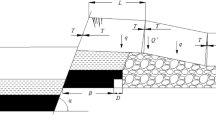Abstract
One of the most significant challenges of construction of underground large size structures is to determine the effect of the geological discontinuities. Fault is a natural discontinuity which allows significant displacement of the rock mass along the fault plane and increases the plastic zones around the underground structure. For instance, an underground hydropower plant comprising more than two underground caverns and large distance between the underground cavern incurs the higher cost because of connecting tunnels or transfer of electricity from powerhouse cavern to transformer cavern. However, presence of the fault would result in the increase of the plastic zone and shear displacement along the fault. Thus, with regards to the effect of the fault on the stability of the two parallel caverns, in this paper different numerical models were simulated to study the effect of the fault on plastic zone around the cavern group and pillar between the caverns, and shear displacement along the fault plane under different scenarios such as fault location, fault dip angle, fault friction angle and in-situ stress conditions. The results are produced graphically and discussed. These results offer advance guidelines in construction of the two parallel large size caverns.
Similar content being viewed by others
References
Abdollahipour, A. and Rahmannejad, R. (2012) Investigating the effects of lateral stress to vertical stress ratios and caverns shape on the cavern stability and sidewall displacements. Arab. Jour. Geosci., v.6, pp.4811–4819.
Ardeshiri-Lajimi, S., Yazdani, M. and Langroudi, A.A. (2015) Control of fault lay-out on seismic design of large underground caverns. Tunnelling and Underground Space Technology, v.50, pp.305–316.
Brekke, T.L. and Selmer-Olsen, R. (1965) Stability problems in underground constructions caused by montmorillonite-carrying joints and faults. Engg. Geol., v.1, pp.3–19.
Deng, S., Li, J., Jiang, H. and Wang, M. (2018). Experimental and Theoretical Study of the Fault Slip Events of Rock Masses Around Underground Tunnels Induced by External Disturbances. Engg. Geol., v.233, pp.191–199.
Hao, Y.H. and Azzam, R. (2005) The plastic zones and displacements around underground openings in rock masses containing a fault. Tunnelling and Underground Space Technology, v.20, pp.49–61.
Hoek E. and Brown E.T. (1980) Underground Excavations in Rock (1st ed.). London Instit. Min. Metall., London, 527 p.
Hoek, E. and Diederichs, M.S. (2006) Empirical estimation of rock mass modulus. Internat. Jour.Rock Mech. Min. Sci., v.43, pp.203–215.
Hoek, E., Carranza-Torres, C. and Corkum, B. (2002) Hoek-Brown failure criterion-2002 edition. In: Proc. 5th North American Rock Mechanics Symposium, Toronto, Canada, v.1, pp. 267–273.
Itasca Consulting Group, Inc. (2016). 3DEC- Three-Dimensional Distinct element code, Ver. 5.2. Minneapolis: Itasca.
Jeon, S., Kim, J., Seo, Y. and Hong, C. (2004) Effect of a fault and weak plane on the stability of a tunnel in rock-a scaled model test and numerical analysis. Internat. Jour.Rock Mech. Min. Sci., v.41, pp.658–663.
Jiang, Q., Feng, Xt., Fan, Y., Fan, Q., Liu, G., Pei, S. and Duan, S. (2017) In situ experimental investigation of basalt spalling in a large underground powerhouse cavern. Tunnelling and Underground Space Technology, v.86, pp.82–94.
Li, Hb., Liu, Mc., Xing, Wb., Shao, S. and Zhou, Jw. (2017) Failure Mechanisms and Evolution Assessment of the Excavation Damaged Zones in a Large-Scale and Deeply Buried Underground Powerhouse. Rock Mech. Rock Engg., v.50, pp.1883–1900.
Lu, W., Chen, M., Geng, X., Shu, D. and Zhou, C. (2012) A study of excavation sequence and contour blasting method for underground powerhouses of hydropower stations. Tunnelling and Underground Space Technology, v.29, pp.31–39.
Ma, K., Feng, B., Zhuang, D.Y., Guo, X.F. and Gao, Q. (2020) Distance effects of the fault on the surrounding rock mass stability of the main powerhouse at the Huanggou pumped-storage power station. Tunnelling and Underground Space Technology, v.106, 103568.
Rehbock-Sander, M. and Jesel, T. (2018) Fault induced rock bursts and micro-tremors-Experiences from the Gotthard Base Tunnel. Tunnelling and Underground Space Technology, v.81, pp.358–366.
Salehi, B. (2017) Cavern design philosophy under high stress rock condition a case study in Sri Lanka. Amer. Jour. App;. Sci., v.14, pp.406–416.
Sayeed, I. and Khanna, R. (2016) Geotechnical investigations for locating an underground powerhouse in calcareous rocks, Himachal Pradesh, India. In: Proc. Conference on Recent Advances in Rock Engineering. pp.141–148, doi:https://doi.org/10.2991/rare-16.2016.23.
Wang, X., Xiong, Q., Zhou, H., Chen, J. and Xiao, M. (2020) Three-dimensional (3D) dynamic finite element modeling of the effects of a geological fault on the seismic response of underground caverns. Tunnelling and Underground Space Technology, v.96, 103210.
Zhang, Z., Chen, F., Li, N., Swoboda, G. and Liu, N. (2017) Influence of fault on the surrounding rock stability of a tunnel: Location and thickness. Tunnelling and Underground Space Technology, v.61, pp.1–11.
Zhao, B. and Ma, Z. (2009) Influence of cavern spacing on the stability of large cavern groups in a hydraulic power station. Internat. Jour.Rock Mech. Min. Sci., v.46, pp.506–513.
Author information
Authors and Affiliations
Corresponding author
Rights and permissions
About this article
Cite this article
Prajapati, S.K., Verma, A.K. Effect of Fault Characteristics on Plastic Zones around Parallelly Spaced Two Underground Caverns and Shear Displacement along the Fault Plane. J Geol Soc India 99, 765–772 (2023). https://doi.org/10.1007/s12594-023-2383-0
Received:
Accepted:
Published:
Issue Date:
DOI: https://doi.org/10.1007/s12594-023-2383-0




